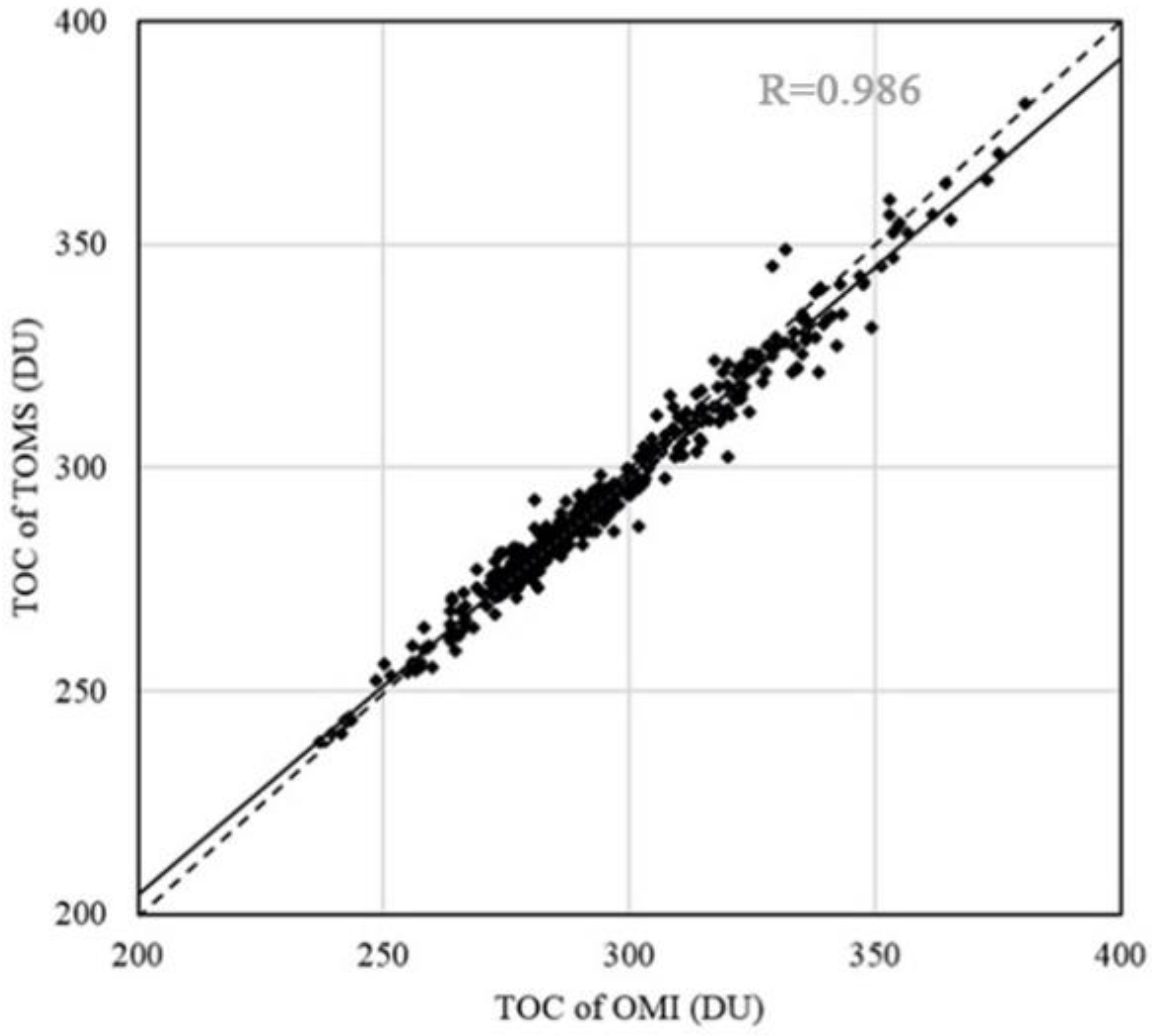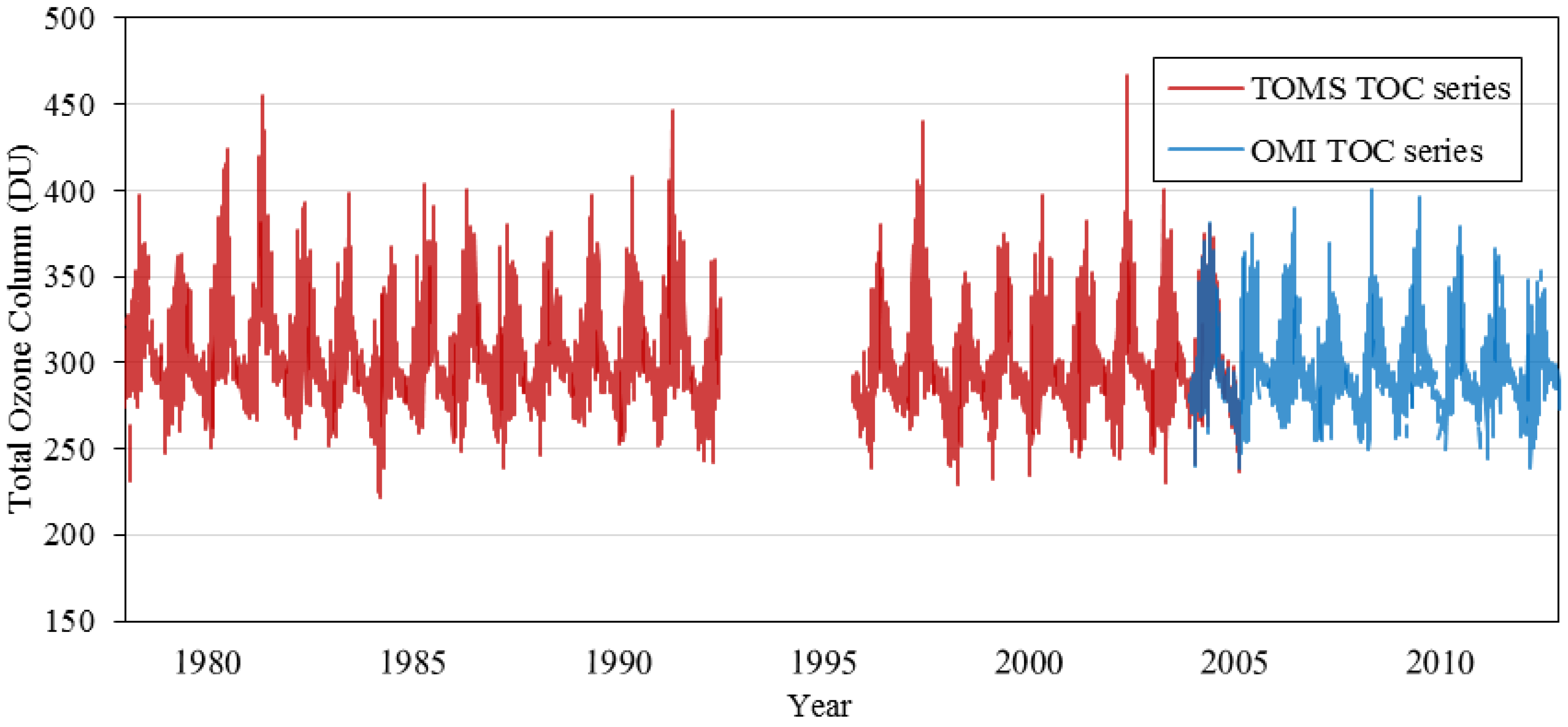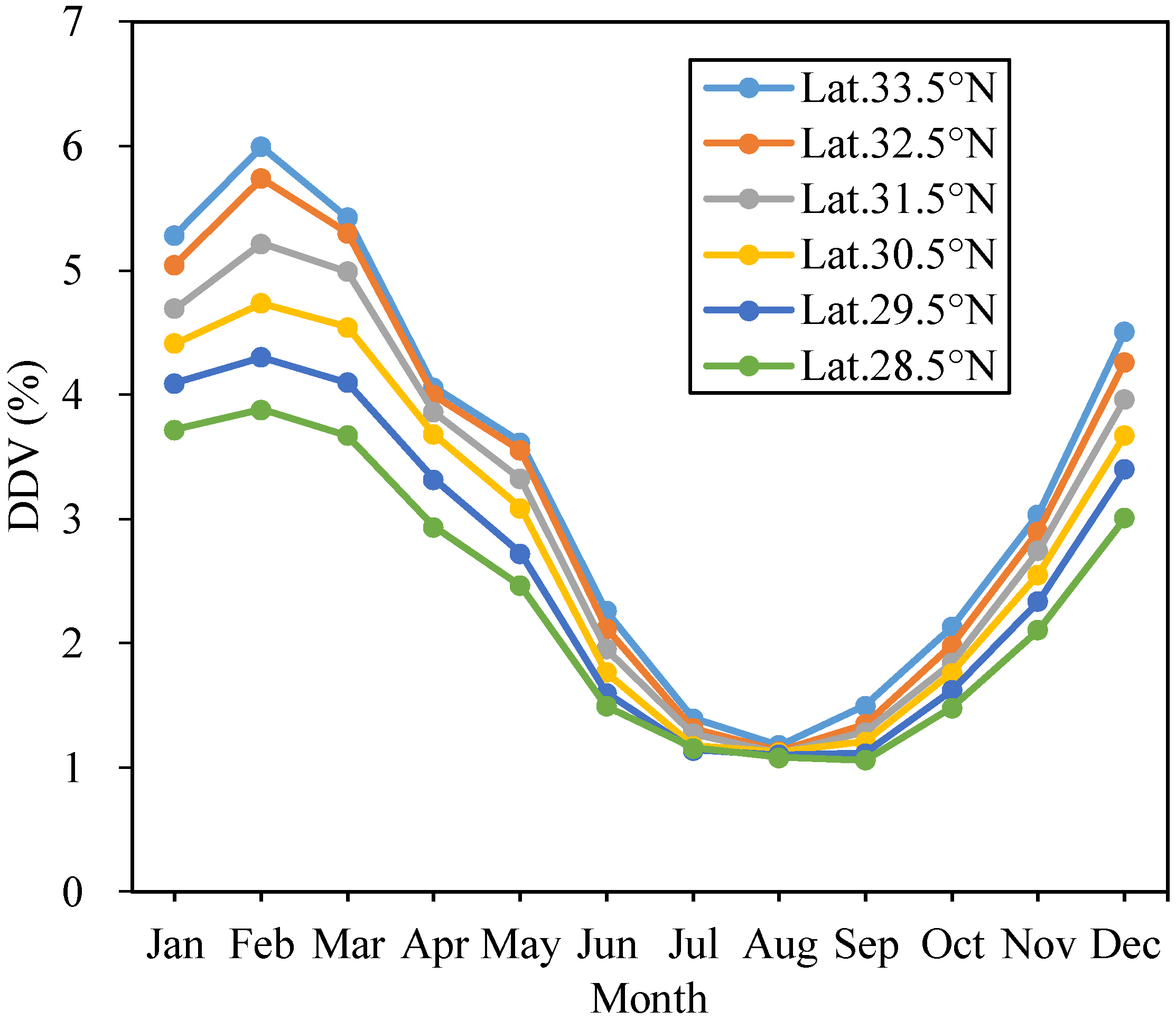Investigating the Temporal and Spatial Variability of Total Ozone Column in the Yangtze River Delta Using Satellite Data: 1978–2013
Abstract
:1. Introduction

2. Data
3. Methodology
4. Results and Discussions
4.1 Spatial Variability

| Average (DU) | SD (DU) | R2 | |
|---|---|---|---|
| 33.5°N–28.5°N | 21.9 | 8.9 | 0.55 |
| 33.5°N–29.5°N | 18.2 | 7.5 | 0.67 |
| 33.5°N–30.5°N | 13.4 | 5.7 | 0.79 |
| 33.5°N–31.5°N | 8.3 | 3.7 | 0.89 |
| 33.5°N–32.5°N | 4.0 | 1.8 | 0.96 |
| Average(DU) | SD(DU) | R2 | |
|---|---|---|---|
| 123.125°W–118.125°W | 1.7 | 0.2 | 0.85 |
| 123.125°W–119.375°W | 1.0 | 0.1 | 0.90 |
| 123.125°W–120.625°W | 0.4 | 0.0 | 0.95 |
| 123.125°W–121.875°W | 0.3 | −0.1 | 0.98 |
4.2. Temporal Variability
4.2.1. Long-Term Variability



| 1978–1999 (DU/Decade) | 2004–2013 (DU/Decade) | |
|---|---|---|
| January | −9.9 ± 1.2 | −5.4 ± 1.4 |
| February | −5.0 ± 1.4 | −22.7 ± 1.9 |
| March | −6.8 ± 1.3 | −4.4 ± 1.6 |
| April | −8.0 ± 0.9 | −10.3 ± 1.5 |
| May | −10.5 ± 0.9 | −12.0 ± 1.0 |
| June | −3.2 ± 0.7 | −2.7 ± 0.7 |
| July | −3.5 ± 0.4 | +4.2 ± 0.3 |
| August | −3.4 ± 0.3 | +3.5 ± 0.3 |
| September | −3.4 ± 0.3 | +1.2 ± 0.4 |
| October | −2.6 ± 2.0 | −12.6 ± 0.7 |
| November | −7.0 ± 0.7 | +9.0 ± 1.0 |
| December | −8.0 ± 0.9 | +3.8 ± 1.3 |
| Mean | −6.5 ± 0.3 | −1.8 ± 0.4 |

4.2.2. Seasonal Variability

4.2.3. Short-Term Variability


5. Conclusions
Acknowledgments
Author Contributions
Conflicts of Interest
References
- Cornu, A. Observation de la limite ultraviolette du spectre solaire adiverses altitudes. CR Hebd. Seances Acad. Sci. 1879, 89, 808. [Google Scholar]
- Molina, M.J.; Rowland, F.S. Stratospheric sink for chlorofluoromethanes: Chlorine atom-catalysed destruction of ozone. Nature 1974, 249, 810–812. [Google Scholar] [CrossRef]
- Rowland, F.; Molina, M.J. Chlorofluoromethanes in the environment. Rev. Geophys. 1975, 13, 1–35. [Google Scholar] [CrossRef]
- Farman, J.; Gardiner, B.; Shanklin, J. Large losses of total ozone in antarctica reveal seasonal clox/nox interaction. Nature 1985, 315, 207–210. [Google Scholar] [CrossRef]
- Stolarski, R.S.; Krueger, A.J.; Schoeberl, M.R.; McPeters, R.D.; Newman, P.A.; Alpert, J. Nimbus 7 satellite measurements of the springtime antarctic ozone decrease. Nature 1986, 322, 808–811. [Google Scholar] [CrossRef]
- Bojkov, R.; Bishop, L.; Hill, W.; Reinsel, G.; Tiao, G. A statistical trend analysis of revised dobson total ozone data over the northern hemisphere. J. Geophys. Res.: Atmos. 1990, 95, 9785–9807. [Google Scholar] [CrossRef]
- Atkinson, R.J.; Matthews, W.A.; Newman, P.A.; Plumb, R.A. Evidence of the mid-latitude impact of antarctic ozone depletion. Nature 1989, 340, 290–294. [Google Scholar] [CrossRef]
- Staehelin, J.; Renaud, A.; Bader, J.; McPeters, R.; Viatte, P.; Hoegger, B.; Bugnion, V.; Giroud, M.; Schill, H. Total ozone series at Arosa (Switzerland): Homogenization and data comparison. J. Geophys. Res.: Atmos. 1998, 103, 5827–5841. [Google Scholar] [CrossRef]
- Varotsos, C.A.; Cracknell, A.P.; Tzanis, C. The exceptional ozone depletion over the arctic in January–March 2011. Remote Sens. Lett. 2012, 3, 343–352. [Google Scholar] [CrossRef]
- Svendby, T.; Dahlback, A. Statistical analysis of total ozone measurements in Oslo, Norway, 1978–1998. J. Geophys. Res.: Atmos. 2004, 109, D16107. [Google Scholar] [CrossRef]
- Ganguly, N.D.; Tzanis, C. Study of stratosphere-troposphere exchange events of ozone in India and greece using ozonesonde ascents. Meteorol. Appl. 2011, 18, 467–474. [Google Scholar] [CrossRef]
- Varotsos, C.; Milinevsky, G.; Grytsai, A.; Efstathiou, M.; Tzanis, C. Scaling effect in planetary waves over Antarctica. Int. J. Remote Sens. 2008, 29, 2697–2704. [Google Scholar] [CrossRef]
- Madronich, S.; McKenzie, R.L.; Björn, L.O.; Caldwell, M.M. Changes in biologically active ultraviolet radiation reaching the Earth’s surface. J. Photochem. Photobiol. B: Biol. 1998, 46, 5–19. [Google Scholar] [CrossRef]
- Longstreth, J.; de Gruijl, F.; Kripke, M.; Abseck, S.; Arnold, F.; Slaper, H.; Velders, G.; Takizawa, Y.; van der Leun, J. Health risks. J. Photochem. Photobiol. B: Biol. 1998, 46, 20–39. [Google Scholar] [CrossRef]
- Kondratyev, K.Y.; Varotsos, C.A. Global total ozone dynamics. Environ. Sci. Poll. Res. 1996, 3, 153–157. [Google Scholar] [CrossRef]
- WMO, W. Scientific Assessment of Ozone Depletion: 2006; Global Ozone Research and Monitoring Project–Report; World Meteorological Organisation: Geneva, Switzerland, 2007; Volume 50, p. 572. [Google Scholar]
- Caldwell, M.M.; Björn, L.O.; Bornman, J.F.; Flint, S.D.; Kulandaivelu, G.; Teramura, A.H.; Tevini, M. Effects of increased solar ultraviolet radiation on terrestrial ecosystems. J. Photochem. Photobiol. B: Biol. 1998, 46, 40–52. [Google Scholar] [CrossRef]
- Ziemke, J.R.; Chandra, S.; Bhartia, P.K. A 25-year data record of atmospheric ozone in the pacific from total ozone mapping spectrometer (toms) cloud slicing: Implications for ozone trends in the stratosphere and troposphere. J. Geophys. Res.-Atmos. 2005, 110, D15105. [Google Scholar] [CrossRef]
- Staehelin, J.; Harris, N.; Appenzeller, C.; Eberhard, J. Ozone trends: A review. Rev. Geophys. 2001, 39, 231–290. [Google Scholar] [CrossRef]
- Houghton, J.T. Climate Change 1995: The Science of Climate Change: Contribution of Working Group I to the Second Assessment Report of the Intergovernmental Panel on Climate Change; Cambridge University Press: Cambridge, UK, 1996; Volume 2. [Google Scholar]
- Bowman, K.P.; Krueger, A.J. A global climatology of total ozone from the Nimbus 7 total ozone mapping spectrometer. J. Geophys. Res.: Atmos. 1985, 90, 7967–7976. [Google Scholar] [CrossRef]
- Fahey, D.W.; Hegglin, M.I. Twenty Questions and Answers about the Ozone Layer 2010 Update: Scientific Assessment of Ozone Depletion 2010; World Meteorological Organisation: Geneva, Switzerland, 2011. [Google Scholar]
- Hoffmann, M.J. Ozone Depletion and Climate Change: Constructing a Global Response; SUNY Press: New York, NY, USA, 2012. [Google Scholar]
- Cheng, Z.; Wang, S.; Jiang, J.; Fu, Q.; Chen, C.; Xu, B.; Yu, J.; Fu, X.; Hao, J. Long-term trend of haze pollution and impact of particulate matter in the Yangtze River Delta, China. Environ. Poll. 2013, 182, 101–110. [Google Scholar] [CrossRef]
- Stolarski, R.S.; Bloomfield, P.; McPeters, R.D.; Herman, J.R. Total ozone trends deduced from Nimbus 7 TOMS data. Geophys. Res. Lett. 1991, 18, 1015–1018. [Google Scholar] [CrossRef]
- Herman, J.; Hudson, R.; McPeters, R.; Stolarski, R.; Ahmad, Z.; Gu, X.Y.; Taylor, S.; Wellemeyer, C. A new self-calibration method applied to toms and sbuv backscattered ultraviolet data to determine long-term global ozone change. J. Geophys. Res.: Atmos. (1984–2012) 1991, 96, 7531–7545. [Google Scholar] [CrossRef]
- Fioletov, V.; Bodeker, G.; Miller, A.; McPeters, R.; Stolarski, R. Global and zonal total ozone variations estimated from ground-based and satellite measurements: 1964–2000. J. Geophys. Res.: Atmos. 2002, 107, ACH 21-21–ACH 21-14. [Google Scholar] [CrossRef]
- Fioletov, V.E.; Shepherd, T.G. Summertime total ozone variations over middle and polar latitudes. Geophys. Res. Lett. 2005, 32, L04807. [Google Scholar]
- Antón, M.; Bortoli, D.; Costa, M.J.; Kulkarni, P.S.; Domingues, A.F.; Barriopedro, D.; Serrano, A.; Silva, A.M. Temporal and spatial variabilities of total ozone column over Portugal. Remote Sens. Environ. 2011, 115, 855–863. [Google Scholar] [CrossRef]
- Chen, Z.; Yu, B.; Huang, Y.; Hu, Y.; Lin, H.; Wu, J. Validation of total ozone column derived from OMPS using ground-based spectroradiometer measurements. Remote Sens. Lett. 2013, 4, 937–945. [Google Scholar] [CrossRef]
- Total, C. WMO Greenhouse Gas Bulletin. Available online: https://www.wmo.int/pages/mediacentre/press_releases/documents/GHG_Bulletin_No.8_en.pdf (13 November 2014).
- NASA Ozone & Air Quality. Available online: http://ozoneaq.gsfc.nasa.gov/index.md (10 December 2013).
- Tandon, A.; Attri, A.K. Trends in total ozone column over India: 1979–2008. Atmos. Environ. 2011, 45, 1648–1654. [Google Scholar] [CrossRef]
- Levelt, P.F.; van den Oord, G.H.; Dobber, M.R.; Malkki, A.; Visser, H.; de Vries, J.; Stammes, P.; Lundell, J.O.; Saari, H. The ozone monitoring instrument. IEEE Trans. Geosci. Remote Sens. 2006, 44, 1093–1101. [Google Scholar] [CrossRef]
- Kroon, M.; Petropavlovskikh, I.; Shetter, R.; Hall, S.; Ullmann, K.; Veefkind, J.; McPeters, R.; Browell, E.; Levelt, P. Omi total ozone column validation with Aura-AVE CAFS observations. J. Geophys. Res.: Atmos. 2008, 113, D15S13. [Google Scholar]
- Kroon, M.; Veefkind, J.P.; Sneep, M.; McPeters, R.D.; Bhartia, P.K.; Levelt, P.F. Comparing OMI-TOMS and OMI-DOAS total ozone column data. J. Geophys. Res.-Atmos. 2008, 113, D16S28. [Google Scholar]
- Fioletov, V.E.; Labow, G.; Evans, R.; Hare, E.W.; Köhler, U.; McElroy, C.T.; Miyagawa, K.; Redondas, A.; Savastiouk, V.; Shalamyansky, A.M.; et al. Performance of the ground-based total ozone network assessed using satellite data. J. Geophys. Res.: Atmos. 2008, 113, D14313. [Google Scholar] [CrossRef]
- Schmalwieser, A.W.; Schauberger, G.; Janouch, M. Temporal and spatial variability of total ozone content over central Europe: Analysis in respect to the biological effect on plants. Agric. For. Meteorol. 2003, 120, 9–26. [Google Scholar] [CrossRef]
- Aesawy, A.; Mayhoub, A.; Sharobim, W. Seasonal variation of photochemical and dynamical components of ozone in subtropical regions. Theor. Appl. Climatol. 1994, 49, 241–247. [Google Scholar] [CrossRef]
- Chen, D.; Nunez, M. Temporal and spatial variability of total ozone in Southwest Sweden revealed by two ground-based instruments. Int. J. Climatol. 1998, 18, 1237–1246. [Google Scholar] [CrossRef]
- Hadjinicolaou, P.; Jrrar, A.; Pyle, J.A.; Bishop, L. The dynamically driven long-term trend in stratospheric ozone over northern middle latitudes. Q. J. R. Meteorol. Soc. 2002, 128, 1393–1412. [Google Scholar] [CrossRef]
- Bowman, K.P. Global patterns of the quasi-biennial oscillation in total ozone. J. Atmos. Sci. 1989, 46, 3328–3343. [Google Scholar] [CrossRef]
- Zerefos, C.S.; Bais, A.F.; Ziomas, I.C.; Bojkov, R.D. On the relative importance of quasi-biennial oscillation and El Nino/southern oscillation in the revised dobson total ozone records. J. Geophys. Res.: Atmos. (1984–2012) 1992, 97, 10135–10144. [Google Scholar] [CrossRef]
- Ziemke, J.; Chandra, S.; McPeters, R.; Newman, P. Dynamical proxies of column ozone with applications to global trend models. J. Geophys. Res.: Atmos. 1997, 102, 6117–6129. [Google Scholar] [CrossRef]
- Hadjinicolaou, P.; Pyle, J.; Harris, N. The recent turnaround in stratospheric ozone over northern middle latitudes: A dynamical modeling perspective. Geophys. Res. Lett. 2005, 32, L12821. [Google Scholar] [CrossRef]
- Harris, N.R.; Kyrö, E.; Staehelin, J.; Brunner, D.; Andersen, S.-B.; Godin-Beekmann, S.; Dhomse, S.; Hadjinicolaou, P.; Hansen, G.; Isaksen, I. Ozone trends at northern mid- and high latitudes—A European perspective. Ann. Geophys. 2008, 26, 1207–1220. [Google Scholar] [CrossRef]
- Robock, A. The climatic aftermath. Science 2002, 295, 1242–1244. [Google Scholar] [CrossRef] [PubMed]
- Tourpali, K.; Schuurmans, C.; van Dorland, R.; Steil, B.; Brühl, C. Stratospheric and tropospheric response to enhanced solar UV radiation: A model study. Geophys. Res. Lett. 2003, 30, 1231. [Google Scholar] [CrossRef]
- Camp, C.D.; Tung, K.-K. The influence of the solar cycle and QBO on the late-winter stratospheric polar vortex. J. Atmos. Sci. 2007, 64, 1267–1283. [Google Scholar] [CrossRef]
- Ziemke, J.R.; Chandra, S. Development of a climate record of tropospheric and stratospheric column ozone from satellite remote sensing: Evidence of an early recovery of global stratospheric ozone. Atmos. Chem. Phys. 2012, 12, 5737–5753. [Google Scholar] [CrossRef]
- Solomon, S. Stratospheric ozone depletion: A review of concepts and history. Rev. Geophys. 1999, 37, 275–316. [Google Scholar] [CrossRef]
- Tung, K.K.; Yang, H. Dynamic variability of column ozone. J. Geophys. Res.: Atmos. 1988, 93, 11123–11128. [Google Scholar] [CrossRef]
- Bojkov, R.D.; Fieoletov, V.E. Total ozone variations in the tropical belt: An application for quality of ground based measurements. Meteorol. Atmos. Phys. 1996, 58, 223–240. [Google Scholar] [CrossRef]
- Silva, A.A. A quarter century of TOMS total column ozone measurements over Brazil. J. Atmos. Solar-Terrestr. Phys. 2007, 69, 1447–1458. [Google Scholar] [CrossRef]
- Scott, R.; Haynes, P. Internal interannual variability of the extratropical stratospheric circulation: The low-latitude flywheel. Q. J. R. Meteorol. Soc. 1998, 124, 2149–2173. [Google Scholar] [CrossRef]
- Dobson, G.M.; Harrison, D.; Lawrence, J. Measurements of the amount of ozone in the Earth’s atmosphere and its relation to other geophysical conditions. Part III. Proc. R.Soc. Lond. Ser. A 1929, 122, 456–486. [Google Scholar] [CrossRef]
- Reed, R.J. The role of vertical motions in ozone-weather relationships. J. Meteorol. 1950, 7, 263–267. [Google Scholar] [CrossRef]
- Bethan, S.; Vaughan, G.; Reid, S. A comparison of ozone and thermal tropopause heights and the impact of tropopause definition on quantifying the ozone content of the troposphere. Q. J. R. Meteorol. Soc. 1996, 122, 929–944. [Google Scholar] [CrossRef]
- Steinbrecht, W.; Claude, H.; Köhler, U.; Hoinka, K. Correlations between tropopause height and total ozone: Implications for long-term changes. J. Geophys. Res.: Atmos. 1998, 103, 19183–19192. [Google Scholar] [CrossRef]
- Vaughan, G.; Price, J. On the relation between total ozone and meteorology. Q. J. R. Meteorol. Soc. 1991, 117, 1281–1298. [Google Scholar] [CrossRef]
© 2014 by the authors; licensee MDPI, Basel, Switzerland. This article is an open access article distributed under the terms and conditions of the Creative Commons Attribution license (http://creativecommons.org/licenses/by/4.0/).
Share and Cite
Chen, L.; Yu, B.; Chen, Z.; Li, B.; Wu, J. Investigating the Temporal and Spatial Variability of Total Ozone Column in the Yangtze River Delta Using Satellite Data: 1978–2013. Remote Sens. 2014, 6, 12527-12543. https://doi.org/10.3390/rs61212527
Chen L, Yu B, Chen Z, Li B, Wu J. Investigating the Temporal and Spatial Variability of Total Ozone Column in the Yangtze River Delta Using Satellite Data: 1978–2013. Remote Sensing. 2014; 6(12):12527-12543. https://doi.org/10.3390/rs61212527
Chicago/Turabian StyleChen, Liujia, Bailang Yu, Zuoqi Chen, Bailiang Li, and Jianping Wu. 2014. "Investigating the Temporal and Spatial Variability of Total Ozone Column in the Yangtze River Delta Using Satellite Data: 1978–2013" Remote Sensing 6, no. 12: 12527-12543. https://doi.org/10.3390/rs61212527
APA StyleChen, L., Yu, B., Chen, Z., Li, B., & Wu, J. (2014). Investigating the Temporal and Spatial Variability of Total Ozone Column in the Yangtze River Delta Using Satellite Data: 1978–2013. Remote Sensing, 6(12), 12527-12543. https://doi.org/10.3390/rs61212527






